The baktus first appeared in Scandinavian countries as an element of the national dress of the Norwegians. It characterized the high status of the person wearing the bandage. This is a scarf (or kerchief) in the form of a triangle, which is worn to complement the image or to protect from the wind in cold weather. The baktus can be knitted with knitting needles, choosing an interesting pattern for decoration, a suitable color and size.
Tips for Beginners
The first knitted item should be simple. Beginners are advised to choose simple patterns for baktus from front and back loops. You can try knitting a scarf using the front, back or garter stitch.

Tips for beginners:
- Before work, you need to make a pattern of the baktus. You need to have a clear idea of the size and shape of the cape so that the finished scarf meets the required parameters.
- For baktus, it is better to choose natural yarn that is soft to the touch and does not irritate the skin.
- The knitting needles should be circular with flexible line about 50 cm long.
- Before work, it is necessary to knit a 10x10 cm sample with the pattern chosen as the scarf decoration. This will allow you to pre-calculate the thread consumption and immediately purchase the required amount of the same yarn.
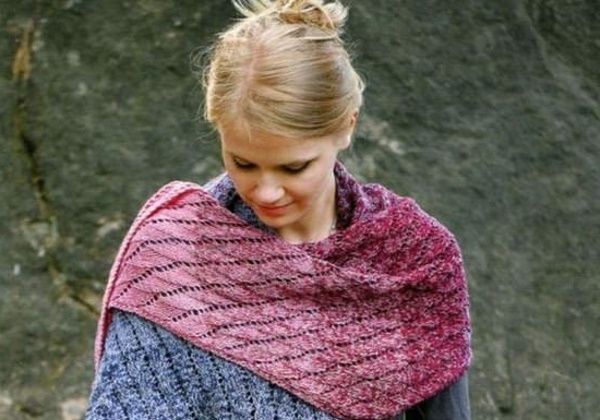
If you imagine a scarf as a triangle standing on a wide base, then you should start knitting from its top (obtuse angle). The expansion of the baktus is achieved by adding loops from 2 sides in each row.
The scarf is worn like an inverted kerchief: with the corner forward. In winter and windy autumn, it protects the neck and face from the wind and snow.
Conventional symbols in instructions
The following notations are used in the description of master classes:
- LP – front loop;
- IP – purl loop;
- P – loop;
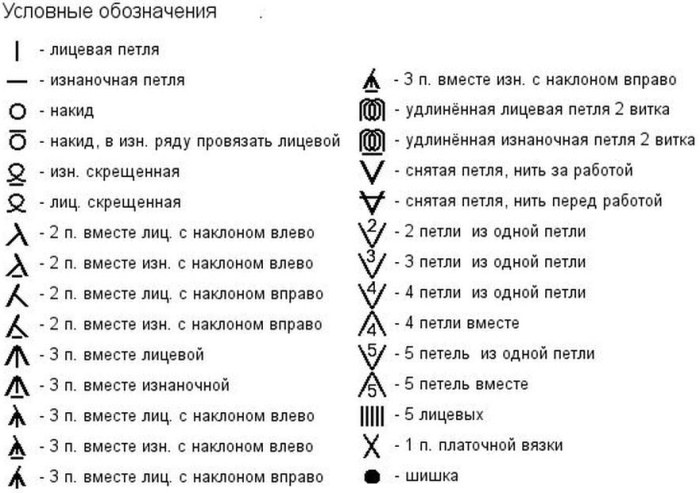
- R – row;
- ND – yarn over;
- KrP – edge loop (the first in a row is removed without knitting and is always purl at the end);
- UB – decrease loops.
Bright baktus made of melange yarn
This version of the baktus is suitable for wearing in autumn and winter. If you choose a thin thread, you can knit a summer accessory. The scarf goes well with a coat or outerwear in the Casual style. It can be combined with everyday outfits or made part of a smart look.
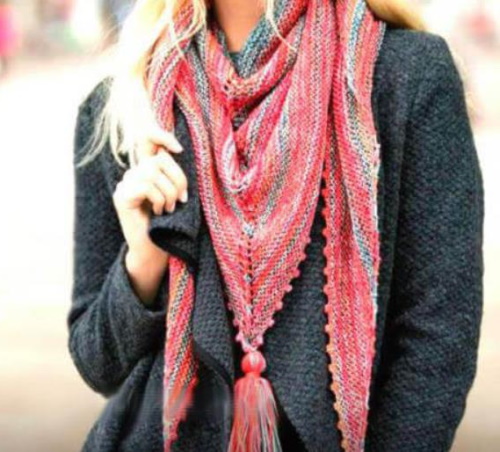
Selection of yarn:
- for summer – silk, cotton;
- for autumn - wool in combination with acrylic;
- for winter – 100% wool.
A scarf with a pattern in red shades will look better on young girls. Women older than years should better support a restrained color of yarn: black with a gray-white gradient, melange in brown and beige tones.
For decoration, pompoms and tassels are sewn to the corners of the baktus. You can trim the scarf with fringe around the perimeter, but then it will be inappropriate to wear it under smart clothes.
Materials, tools and diagrams for work
To knit you need to prepare:
- yarn density 100 m per 50 g (total 300 g);
- knitting needles No. 4;
- hook No. 4.5.
If the knitting needles are circular, you can knit a whole scarf, if separate, you will have to make 2 identical parts of the baktus, and then sew them together. The hook is not a necessary tool in this master class.
The dimensions of the baktus are 180 x 50 cm. The knitting density is 18 P by 32 R, which equals a finished piece of fabric measuring 10 x 10 cm. The main pattern of the scarf is garter stitch, which is done with front rows.
What does the preliminary pattern look like:

The dotted line in the picture indicates the middle of the scarf. The second half is constructed similarly in mirror image.
Knitting pattern for a melange shawl:

Conventional symbols in the diagram:
| Symbol | Transcript |
| 1 KRP | |
| 1 LP | |
| 1 IP | |
| 1 LPs (front crossed loop) | |
| 1 ND | |
| Increase 1 LPs from the transverse thread |
The patterns for the baktus, knitted with needles according to this scheme, are repeated every 2 rows, which simplifies the work on it. After knitting several works, the algorithm is remembered, which allows you to work further without comparing with the instructions.
Knitting algorithm
Knitting begins from the top point of the pattern (the obtuse angle of the triangle).
Information on knitting LPs: knitted in the same way as LP, only for the back wall (in the classic version, LP is knitted for the front wall).

Help on knitting the increase LPs from the transverse thread: you need to pick up the thread between the loops on the knitting needles and knit LP from it behind the back wall.
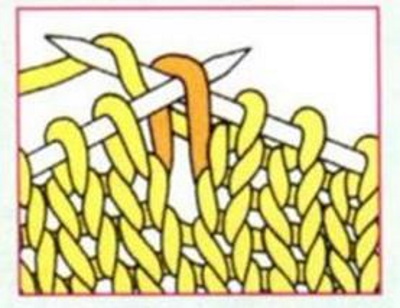
The order of work when performing half a baktus on separate needles:
- Cast on 6P.
- In the first row: KrP, 1 ND, 2 LP, 1 IP, 2 LP, 1 ND, KrP.
- Then knit according to the schematic instructions, starting from the first row.
- After the 6th row, continue knitting similarly to the pattern, only the number of loops in the rows increases from 2 sides every 2 R. At each stage, 6 P. are added to the row.
- Continue knitting until the baktus is 180 cm long.
- The loops are closed.
- They decorate the scarf.
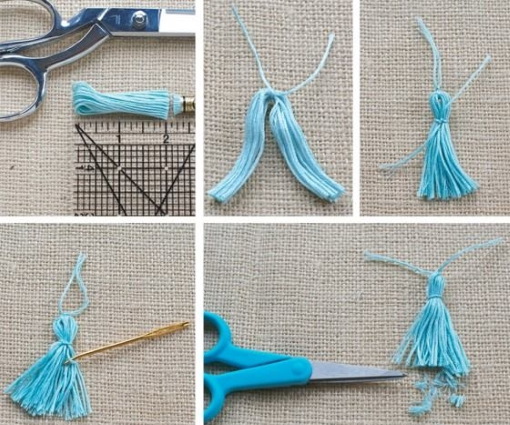
There are several options for decorating baktus:
- Tassels on the corners of the scarf. Cut the thread into 30-32 cm lengths. Make a total of 81 pieces (27 pieces for each corner). Fold the 27 pieces in half.
Step back 3 cm from the fold line and wrap the thread around all the sections (about 10-15 turns). Fix the tassel so that it does not fall apart and sew it to the corner of the scarf. Decorate the other corners of the scarf in the same way.
- Pompoms. Wrap the fork tines with yarn. You need to make about 50 turns of thread. Pass the yarn through the central gap between the fork tines, make 2 tight turns around all the turns of yarn, make a knot.

Cut the yarn on both sides of the fork, remove the pompom and fluff it up, sew it to the baktus. Make 2 more pompoms for the other corners of the scarf.
- Crochet edge binding. When there are 373 P in 123 R on the needles, carefully pull the needle out of the loops. You need to make sure that the loops do not unravel. You can pull the tool out gradually, removing the required number of loops.
From 2 removed loops make a slip stitch, in the next loop make a picot (3 VP, 1 SbN, 1 VP). Then continue to the end of the row alternating 1 SS and picot. You can combine several types of decoration: crochet trim with pompoms or tassels at the corners of the baktus.
Bactus with a solid color pattern
This is a lightweight scarf that is suitable for autumn. The color of the yarn can be chosen to match your wardrobe. The threads should be chosen from natural materials, since synthetics do not retain heat, which means that a baktus made of artificial yarn will only serve as an accessory and will not warm you in windy and rainy weather.
Materials, tools and diagrams for work
Patterns for a baktus knitted with your own hands can be simple, but look stylish.
To knit a scarf with one of these decor options, you need:
- 4 skeins of yarn 90 x 50 g, consisting of 40% alpaca, 40% merino, 20% silk.
- Circular knitting needles No. 5.5.
- Hook No. 5.5 (optional).
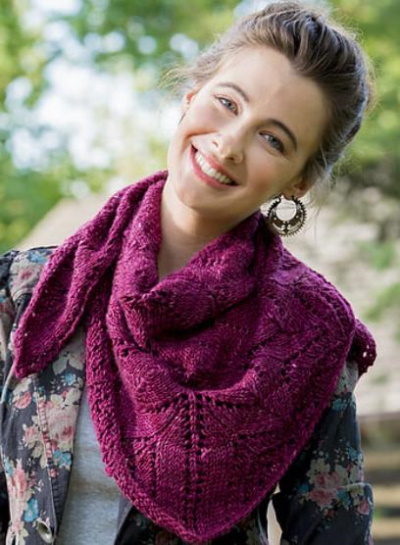
The dimensions of the baktus are 127 x 56 cm. The length of one short side of the triangle will be 84 cm. Knitting density is 16 P by 20 R in stocking stitch. The diagrams show the right half of the baktus and the central loop. They should be read from right to left to the central loop.
The left part is knitted in mirror image: from left to right. The pattern rapport is indicated on the diagrams by green stripes. As rows 1-12 from diagram #3 are repeated, the number of rapports across the width of the scarf will increase.
The purl rows are not shown in diagrams #2 and #3. They are done by alternating 2 LP, 1 IP to the last 2 loops, which are knitted as 2 LP.
Scheme #1:
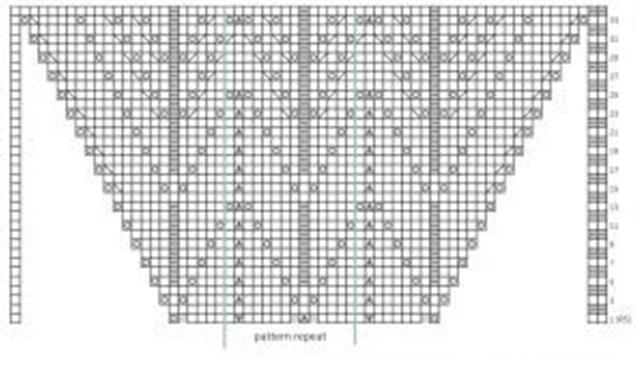
Scheme #2:
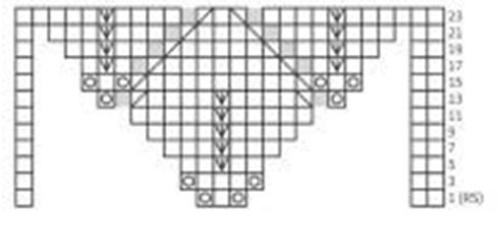
Scheme #3:

Conventional symbols in diagrams:
| UB 2 loops (slip 1 st, knit 2 sts together as if knitting, pull the slipped loop through the knitted one). | |
| 2 P together with the front stretch. | |
| 2 P together as LP. | |
| No loop or skip. | |
| Yarn over. | |
| 3 P from one (1 LP, ND, 1 LP). | |
| LP on front rows, IP on back rows. | |
| LP on purl rows, IP on front rows. |
Knitting algorithm
The patterns for the baktus, knitted with knitting needles according to this master class, begin with pattern No. 2, then No. 3 and lastly repeat pattern No. 1.
Work order:
- Using a crochet hook, cast on a chain of 4 air loops with an additional thread. Using the knitting needles, cast on 1 LP from each convex element on the back side of the chain with the main thread. There will be 2 P on the knitting needle.
- From 1st to 6th row, knit all stitches as if they were RP.
- 7 R: 2 LP, turn the knitting, pick up 3 P on the needles with an additional thread (1 P from each edge loop), unravel the additional thread, transfer the last 2 picked up loops to the left needle without knitting, make 2 LP. There should be a total of 7 P on the needles.
- According to scheme No. 2, perform 1-24 R. Upon completion, there should be 51 R. in work.
- According to pattern No. 3, perform 1-12 rows 4 times. You should get 167 sts on the needles.
- According to scheme No. 1, perform 1-34 R.
- Close the loops as if to LP, secure the thread, cut and hide its end.
The patterns for the baktus, knitted with needles according to this instruction, are self-sufficient and can serve as the main decoration of the scarf. But the scarf can also be decorated with crochet or tassels at the corners.
Plain baktus with a pattern "Path"
This master class describes the algorithm for knitting a square baktus with an openwork pattern.
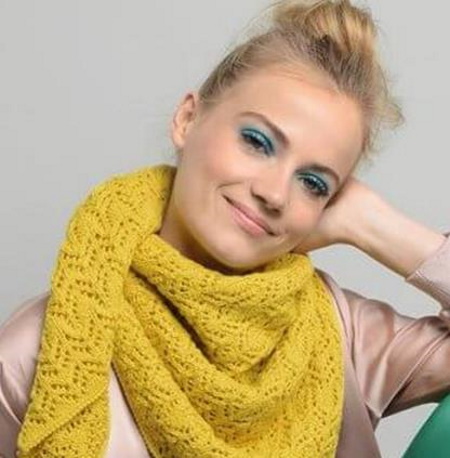
It will suit an autumn look, as it is not knitted from thick yarn with the addition of acrylic.
Materials, tools and diagrams for work
To knit you need to prepare:
- 8 skeins of Lambswool yarn (50% wool and 50% acrylic, 130 m per 50 g);
- circular knitting needles No. 3.5;
- hook number 2.
You can choose other threads, observing the knitting density indicators: 23 P by 37 R will be equal to the area of the fabric measuring 10 x 10 cm. Note on reading the pattern: one frame consists of 26 rows. After they are completed, the pattern shifts in a checkerboard pattern.
Decoding of the circuit elements:
| Symbol | Designation |
| Edge loop | |
| Yarn over | |
| 2 LP together with a tilt to the right | |
| Facial stretch | |
| Double decrease with a front loop |
Explanations for performing the elements:
- Double decrease with a front loop is performed according to the following pattern: in a group of 3 sts, remove the first 2 sts to the working needle, knit the 3rd loop as a front loop and pull it through the 2 removed loops.
- The front loop is performed according to the scheme: in a group of 2 P, remove the first one to the working needle without knitting. Make the second loop as LP. Insert the left needle into the removed loop from left to right. Pull the knitted loop through the removed one.

The diagram for performing the face stitch is above.
Operating procedure
Start knitting by casting on 124 stitches on the needles, and then work according to the pattern:
- Perform 1 KR, knit according to the pattern from 1 to 12 P, repeat the frame pattern (8 P), 1 KR.
- Continue knitting according to the pattern up to 332 R. The height of the fabric should be 90 cm.
- Close the loops as per LP, hide the ends of the threads.
- To process the contours, crochet the scarf around the perimeter in 2 rows: the first - with single crochet stitches, the second - using the crayfish step technique.

The master class describes the instructions for knitting a baktus measuring 90x90 cm. If you need a larger thread, it is increased similarly to the increases in the pattern to the desired length.
Warm winter baktus from angora
The pattern on such a baktus is poorly visible, so it is better to choose knitting patterns with large elements of the pattern. Due to the fluffiness of the threads, small details will be lost against the background of the main plane of the fabric.
Materials, tools and diagram for work
If you follow the master class, you will get a scarf measuring 131 by 54 cm.
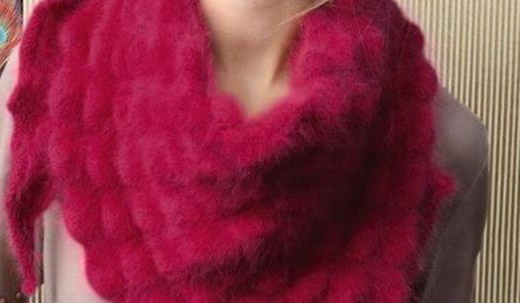
For knitting you will need:
- 4 skeins of Pur Angora yarn (100% angora, 109 m per 25 g).
- Needles No. 3.5.
Angora yarn is warm and pleasant to the touch. A scarf made of it can be worn in cold and windy weather. The knitting density of the shawl is 12.5 cm or 36 R for 40 pattern loops. The peculiarity of the pattern is that the back side of the work will be the front side in the finished scarf.
Knitting pattern:
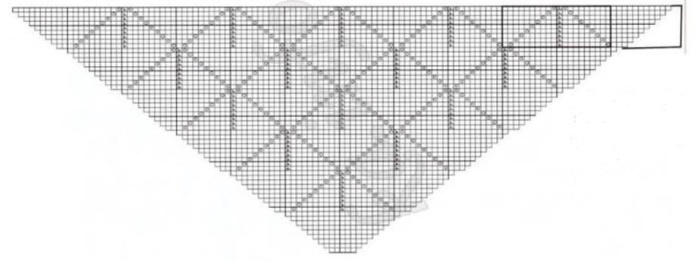
The pattern repeat is added in every 9th row.
Conventional symbols in the diagram:
| LP in front rows, IP in back rows. | |
| Double face pull to the front side | |
| Yarn over |
Operating procedure
Start working by casting on stitches:
- Cast on 5 sts onto needles.
- Knit according to the pattern, making increases on each side and in each row: 8 times 1 P and 1 time 2 P.
- Repeat the increases a total of 20 times until the end of knitting the baktus.
- In each 9 R add 1 motif, shifting the pattern in a checkerboard pattern.
- At the end of the work you should get 405 P.
- Close the loops and hide the end of the thread.
Since the yarn is voluminous due to its texture, there is no need to decorate it around the perimeter.
Bactus with a diamond pattern
Baktus in this design is combined with airy, delicate images. It can be worn in early spring and late autumn, as the scarf is quite warm and retains thermoregulation properties at temperatures above 0 °C.
Materials, tools and diagram for work
The following will be used in the work:
- 6 skeins of Phil Light yarn, which contains 50% acrylic, 30% polyamide and 20% wool (300 x 50 g in each skein);
- Needles No. 5.
- Hook No. 5.
Baktus is knitted with a 2-ply thread. To get a delicate pink color, use lilac and cream yarn. In this case, take 3 skeins of each color. The scarf knitted according to this pattern is rectangular. The knitting density is 17 P by 22 rows, which is equal to a square with each side 10 cm long.

Decoding symbols in the knitting pattern:
| LP in front rows, IP in back rows | |
| Yarn over | |
| Facial stretch | |
| 2 LP together | |
| Edge loop |
Operating procedure
To knit a baktus measuring 1 x 1 m, you need to follow the instructions:
- Cast on 155 sts on circular needles.
- Knit the first 2 rows in stockinette stitch.
- Next, knit according to the pattern: 1 KrP, repeat the pattern rapport from 1 to 34 P 4 times, then half the rapport (from 1 to 17 P), 2 KrP.
- Knit according to the pattern in height until 3 high rapports are ready (217 rows).
- Close the loops as per LP, hide the thread.
- Crochet the baktus around the perimeter with single crochet stitches.
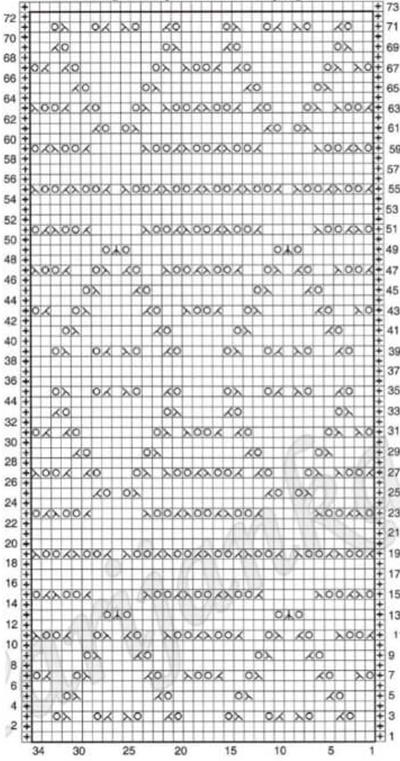
For decoration, you can use fringe around the perimeter of the scarf. It is better not to use pompoms or tassels for decoration, as they will make the beautiful shawl look like a child's scarf.
When working with knitting needles, it is important to maintain the correct thread tension and not change it during the entire knitting process. If you overtighten or, conversely, make the thread tension less, the baktus will be disproportionate and its pattern will be distorted.
Video about knitting
Patterns for knitting baktus:
